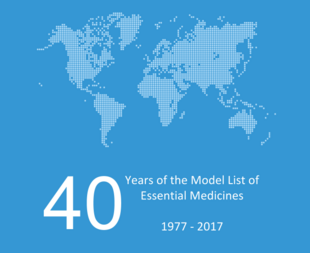
Back الأدوية الأساسية Arabic Melecina esencial AST Основни лекарства Bulgarian অত্যাবশ্যকীয় ওষুধের তালিকা Bengali/Bangla Medicament essencial Catalan Unentbehrliche Arzneimittel German Esencaj medikamentoj Esperanto Medicamento esencial Spanish Funtsezko botika Basque Médicament essentiel French

Essential medicines, as defined by the World Health Organization (WHO), are the medicines that "satisfy the priority health care needs of the population".[1] These are the medications to which people should have access at all times in sufficient amounts. The prices should be at generally affordable levels.[2] Since 1977, the WHO has published a model list of essential medicines, with the current (2019) list for adult patients containing over 400 medicines.[3] Since 2007, a separate list of medicines intended for child patients has been published.[4] Both the WHO adult and children's lists contain a notation indicating that a particular medication is "complementary", thus essentially there are two lists, the "core list" and the "complementary list". The core list presents a list of minimum medicine needs for a basic health care system, listing the most efficacious, safe and cost-effective medicines for priority conditions. Priority conditions are selected on the basis of current and estimated future public health relevance, and potential for safe and cost-effective treatment. The complementary list presents essential medicines for priority diseases, for which specialized diagnostic or monitoring facilities are needed. In case of doubt medicines may also be listed as complementary on the basis of higher costs or less attractive cost-effectiveness in a variety of settings. The list is important because it forms the basis of national drugs policy in more than 155 countries, both in the developed and developing world. Many governments refer to WHO recommendations when making decisions on health spending. Countries are encouraged to prepare their own lists taking into consideration local priorities. Over 150 countries have published an official essential medicines list.[5]
- ^ Cite error: The named reference
WHO2017Webwas invoked but never defined (see the help page). - ^ "The Selection and Use of Essential Medicines (ss 4.2)". Essential Medicines and Health Products Information Portal. WHO Technical Report Series. World Health Organization (WHO). 2003. p. 132. Archived from the original on February 1, 2014.
- ^ Organization WH (2019). "World Health Organization model list of essential medicines: 21st list 2019". World Health Organization. hdl:10665/325771.
- ^ Organization WH (2019). "World Health Organization model list of essential medicines for children: 7th list 2019". World Health Organization. hdl:10665/325772.
- ^ Seyberth HW, Rane A, Schwab M (2011). Pediatric Clinical Pharmacology. Springer Science & Business Media. p. 358. ISBN 978-3-642-20195-0.
© MMXXIII Rich X Search. We shall prevail. All rights reserved. Rich X Search